Published By VITA 1600 Wilson Boulevard, Suite 500 Arlington, Virginia 22209 USA Tel: 703/276-1800 * Fax: 703/243-1865 Internet: pr-info@vita.org
Understanding Solar Energy: a General Overview ISBN: 0-86619-233-9 [C] 1985, Volunteers in Technical Assistance
PREFACE
This paper is one of a series published by Volunteers in Technical Assistance to provide an introduction to specific state-of-the-art technologies of interest to people in developing countries. The papers are intended to be used as guidelines to help people choose technologies that are suitable to their situations. They are not intended to provide construction or implementation details. People are urged to contact VITA or a similar organization for further information and technical assistance if they find that a particular technology seems to meet their needs.
The papers in the series were written, reviewed, and illustrated almost entirely by VITA Volunteer technical experts on a purely voluntary basis. Some 500 volunteers were involved in the production of the first 100 titles issued, contributing approximately 5,000 hours of their time. VITA staff included Maria Giannuzzi as editor, Julie Berman handling typesetting and layout, and Margaret Crouch as project manager.
The author of this paper, VITA Volunteer Keith Giarman, has a strong background in conventional and alternative energy technologies, particularly in policy issues relative to developing countries. He is currently an editor in the communications division of NUS Corporation in Gaithersburg, Maryland, an international consulting firm that specializes in various energy and environmental matters. The reviewers of this paper are also VITA Volunteers with experience in solar energy. Kevin Finneran is the research director of the Solar Energy Industries Association. He has worked as a consultant in the United States and in developing countries for the International Institute for Environment and Development and for the U.S. Agency for International Development. Christopher Flavin is a senior researcher for the Worldwatch Institute in Washington, D.C., where he researches and writes papers and books on energy technologies and policies with an international perspective.
VITA is a private, nonprofit organization that supports people working on technical problems in developing countries. VITA offers information and assistance aimed at helping individuals and groups to select and implement technologies appropriate to their situations. VITA maintains an international Inquiry Service, a specialized documentation center, and a computerized roster of volunteer technical consultants; manages long-term field projects; and publishes a variety of technical manuals and papers.
I. INTRODUCTION
Developing countries are in a particularly good position to use solar energy because so many receive an abundance of sunshine. More important, the inhabitants of these countries are frequently scattered over vast areas, making access to electricity or conventional fossil fuels difficult as well as expensive. Many solar systems are easily built and operated, thus providing a readily available source of energy at an affordable price. People in poorer regions of the globe, moreover, need energy primarily for low-temperature applications--cooking food, drying crops, and purifying water--to fulfill their most basic human needs. Solar energy can satisfy these low-temperature needs and give Third World inhabitants a welcome alternative to the burning of traditional fuels: wood, dung, and agricultural waste (biomass).
The poor throughout the world are caught in a vicious cycle. As they burn more and more wood to cook and stay warm, they gradually undermine their ability to feed themselves in the future. Uncontrolled and inefficient biomass combustion leads to malnourished soil; nitrogen-rich organic matter is burned for fuel instead of being added to the earth. The cost of replacing these lost nutrients with chemical fertilizers is prohibitively high in much of the Third World. Couple this problem with the deleterious effects of erosion and desertification, as well as the adverse health effects of indoor and outdoor air pollution caused by the burning of biomass, and the need for alternative energy forms in developing countries becomes clear.
Of course, the electrification of Third World villages is the first step to their modernization and, eventually, better economic conditions for the poor via new industry. Electricity is needed in many areas for water pumping, communications, refrigeration, lighting, and other uses. Photovoltaic (PV) cells, which directly convert sunlight to electricity, are transportable, environmentally clean, and easily operated; thus, they are particularly well suited for providing electricity in rural villages. At present, however, PV is only cost competitive with fossil-fuel generators in the most remote sections of the world.
The effective application of solar systems, like other technologies, can be problematic in developing countries. Cultural and climatic conditions. Unique to a given region, along with the materials, tools, and manpower available in that area, must be considered before introducing solar technologies. Too many efforts to introduce worthwhile energy programs and technologies have failed over the years, because local factors have been overlooked.
While sunlight reaching Third World countries is generally quite abundant compared with industrialized nations, a country's geographical location and climate help determine the feasibility of solar energy systems. Compared to industrialized countries, many developing countries are generally closer to the equator and therefore receive stronger and more consistent solar energy supply. It is unwise to implement solar technologies in any area, however, without considering fluctuations in the availability of light.
Local climatological variables, like cloud cover, can interfere with the receipt of solar radiation, limiting the applicability of solar energy in even the warmest portions of the globe. For this reason, the common assumption that the tropics are a uniformly desirable area for solar energy may be overstated. Solar crop drying devices, for instance, are useless in a normally sunny tropical area where harvest time and a seasonal increase in cloud cover coincide.
As already suggested, cultural factors can also have a profound influence on the introduction of solar systems, even in areas with ideal climate and abundant resources. In Africa, for example, women from some tribes have cooked with wood before sunrise or after sunset for years. How does one convince them that it is better to use solar cookers during the day? Changing social habits can take time and many cultural practices have a practical foundation not immediately visible to outside researchers. As a result, programs for introducing solar technologies must be flexible enough to accommodate these cultural preferences.
What is important in this general overview of solar energy is that a multitude of factors--social, climatological, technical, and economic--will dictate the success or failure of a project in any area. The key to effective use of solar energy is identifying the specific applications where it matches the needs, resources, and social infrastructure of the people. In the discussion that follows, the potential obstacles to the introduction of solar energy will be examined briefly in relation to specific solar systems.
II. OPERATING PRINCIPLES
BASIC THEORY
Except for photovoltaic cells, solar energy is harnessable in either of two ways: via active or passive systems. () Passive systems absorb or focus the sun's radiation without the aid of a moving medium, such as circulating water. Passive solar collectors focus or collect and strategically trap heat, that is, allow the heat to enter but not to escape. A typical passive collector will allow sunlight to pass through glass, onto a dark, heat-absorbing backdrop. The heat is trapped for a useful function, perhaps to cook a chicken in a solar oven. Or light can simply be focused onto a certain area, say the bottom of a pot in a solar cooker, to heat the contents to a desired temperature. In other passive systems, the natural thermosyphon effect () can be used to circulate heated air to a home or barn for space heating.
Active solar systems are a bit more complicated, since a circulating medium (usually water) must be heated to make these systems function. In a typical solar set-up, so called flat plate' collectors absorb heat from the sun via a large, flat, dark surface area. The heat is transferred to a liquid that circulates through tubes or channels that are part of the absorber surface. The water can then be stored and tapped when necessary to perform useful tasks that require hot water (washing utensils, personal hygiene, pre-heating water for boiling, and so forth). Some active solar systems use reflective surfaces to concentrate the sun's rays on a small absorber surface such as a copper tube. These concentrating collectors can produce higher temperatures for commercial and industrial applications.
The sun's energy can also be converted into electricity by using photovoltaic cells. Photovoltaic (or solar) cells convert sunlight directly into electricity, without mechanical generators. The cells are usually composed of silicon, but other semi-conductor materials are also used. When sunlight strikes photovoltaic cells, electrons are dislodged, creating an electrical current which can then be drawn off.
The division between active and passive systems is not clear. Hybrid systems incorporate elements of both. For example, a passive solar structure can be built in such a way as to strategically trap heat; a mechanical device, such as a fan, can be used to move the heated air to other areas of the structure. Thus, both passive and active elements are incorporated in the same system.
* The tendency of heated liquids and gases to rise. In a thermosyphon system, a liquid or gas (air) circulates naturally without means of a fan or pump.
Photovoltaic cells were first used in the 1950s to power space satellites. At that time they were quite expensive, costing more than $1,000 per watt of capacity. Although they are still too costly for widespread use, their price has been brought down to about $10 per watt.
TWO ACTIVE SOLAR ENERGY SYSTEMS: WATER HEATERS AND WATER PUMPS
Active solar systems require a higher capital and labor investment than passive technologies, but they can sometimes provide a quick return on that investment through their low maintenance and zero fuel costs. Moreover, the scarcity of traditional and fossil fuels is so acute in some areas of the globe that active solar water heaters may be the most practical source of substantial quantities of hot water.
Hot water is imperative for modernizing rural areas, since it is the key to improving sanitary conditions in public facilities like health clinics, hospitals, and schools. Of course, hot water is important at the domestic level as well, particularly in personal hygiene to combat disease. Simple active systems made from readily available and inexpensive materials are feasible in areas where fuel and other resources are scarce. A number of simple solar water heaters have been developed which can be built with locally available materials and tools (see Figure 1).
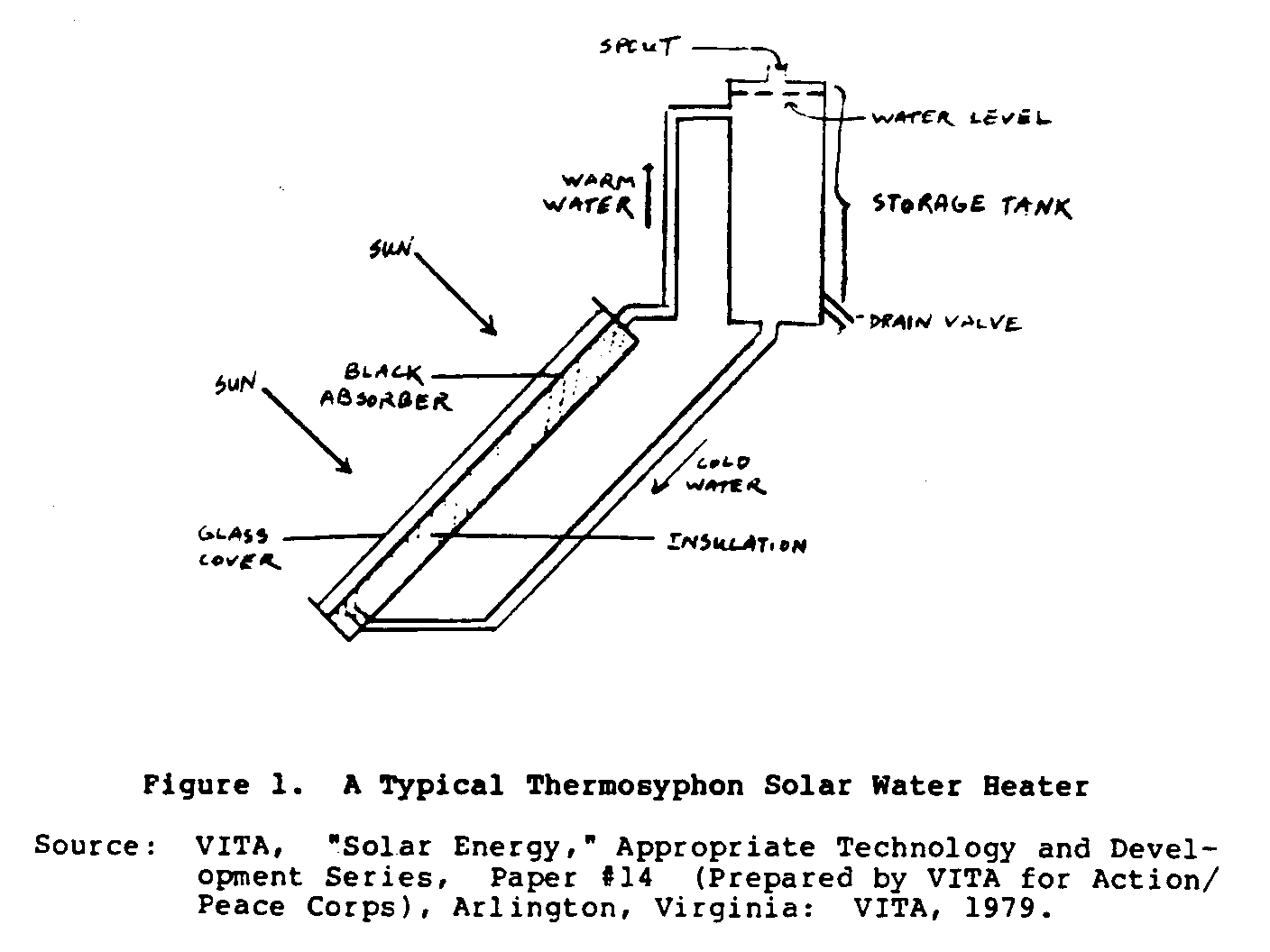
Solar-powered water pumps are also available. Once set up, these pumps are easily operated, but they are mechanically complex. Water must be heated to 70 to 80 [degrees] C by a collector or concentrator apparatus--similar to or the same as in solar heaters. The water then heats a liquid gas (such as Freon), which vaporizes and expands, and drives an engine for pumping. Unlike typical solar water heating systems, such solar pumps cannot be built easily from local materials and tools, and the principle behind their operation is relatively complex. More important, solar water pumps are too expensive for the rural poor. The capital cost varies anywhere from U.S. $6,000 to $78,000 depending on the pump's size, which, when compared to the cost of diesel generators or photovoltaics, makes solar water pumping uneconomical.
PASSIVE SOLAR ENERGY SYSTEMS
Solar Cookers and Ovens
Because less complicated systems are more easily adapted in developing countries, passive solar devices are preferred. Simple solar cookers and ovens are the most practical application of solar energy in these countries (see Figure 2). They can be built
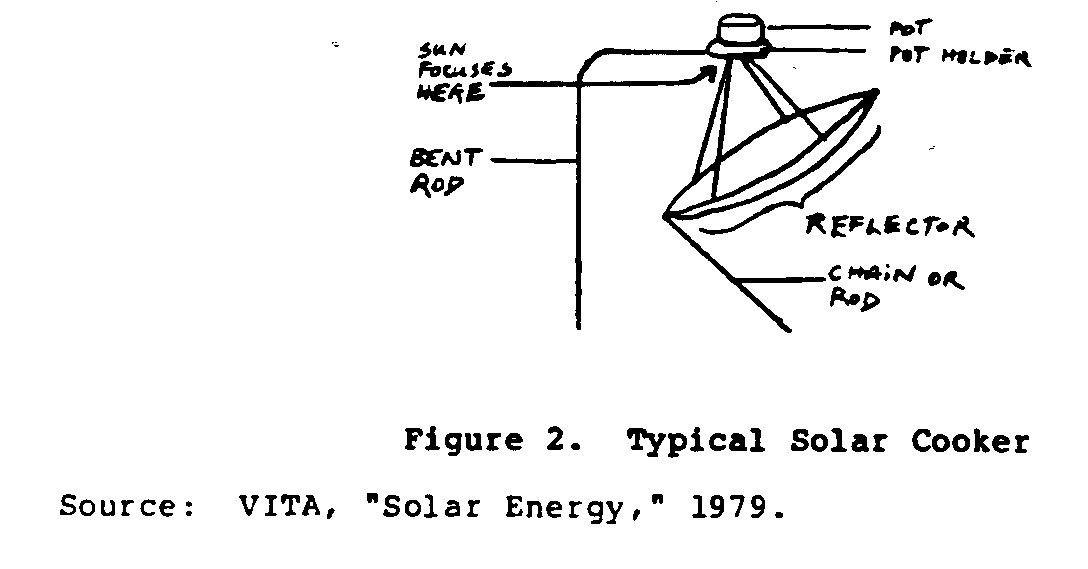
quite easily by individuals using local materials or produced by village industries. High temperature ovens and extremely efficient cookers have been developed. However, cheap, easy-to-use models of polished reflecting metal, or aluminum foil, stand a better chance of acceptance in the poorer regions of the world.
For all their success, solar cookers are a frequently cited example of an energy technology that failed because of cultural, not economic, reasons. For instance, in some areas of Africa where meals are cooked before sunrise or after sunset in accordance with cultural practice, solar cookers have been difficult to introduce. As suggested earlier, altering accepted cooking practices rooted in social convention is a difficult process. Technical complexities and cost can compound these cultural barriers. For example, some villagers have complained about having to adjust the cooker's reflector to refocus the sun's rays on the cooking utensil. In China, the price of cookers is relatively low, U.S. $10-30. But a Chinese family could build a 10 cubic meter biogas unit for U.S. $100.00, which could serve as an essentially unlimited source of energy for a variety of household and agricultural needs. In many instances, it just does not make sense for them to use solar cookers until they become extremely cheap. Depending on the local area, the number of possible obstacles to effective introduction can be great. These barriers must be identified as completely as possible before capital is devoted to program implementation. If properly defined, problems can be circumvented or alleviated. For instance, efforts by a Danish church group to introduce solar cookers in Upper Volta succeeded because villagers helped adapt the cooker to local needs and conditions.
Although there are a number of different designs, solar cookers consist of three basic parts: a reflector, a stand, and a pot holder. Reflectors are usually dish-shaped and have a shiny reflective surface. Aluminum and aluminized mylar have been used successfully to focus the sun's radiation onto the cooking utensil.
The stand can be made of common materials, including wood, metal, tubing, brass, or steel rods. Whatever materials are used, they must be strong enough to support the reflector and withstand outdoor elements (wind in particular). At the same time, the stand must be light so the cooker as a unit is portable.
The pot holder must be constructed to maximize the efficiency of the cooker, that is, the pot must sit near the focal point of the reflected sun's rays, where heat will be spread out over the bottom of the pot. Other factors will contribute to the efficiency of the solar cooking system as well:
* The bottom of the pot should be a dull black color to facilitate heat absorption.
* The pot should be covered.
* The cooker should be operated in bright sun.
* The position of the pot or reflectors should be adjusted every 10-30 minutes to accommodate changes in the sun's angle of incidence.
Solar ovens are different from cookers in that the sun's heat is not simply focused--it is trapped in an enclosed area as well. In a number of places where glass, wood, low-cost reflective material, and some type of insulation are readily available, the solar oven, like the cooker, can be easily built. Cardboard can even be sub-stituted for wood in some designs.
In the solar oven (see Figure 3), the black insulated interior
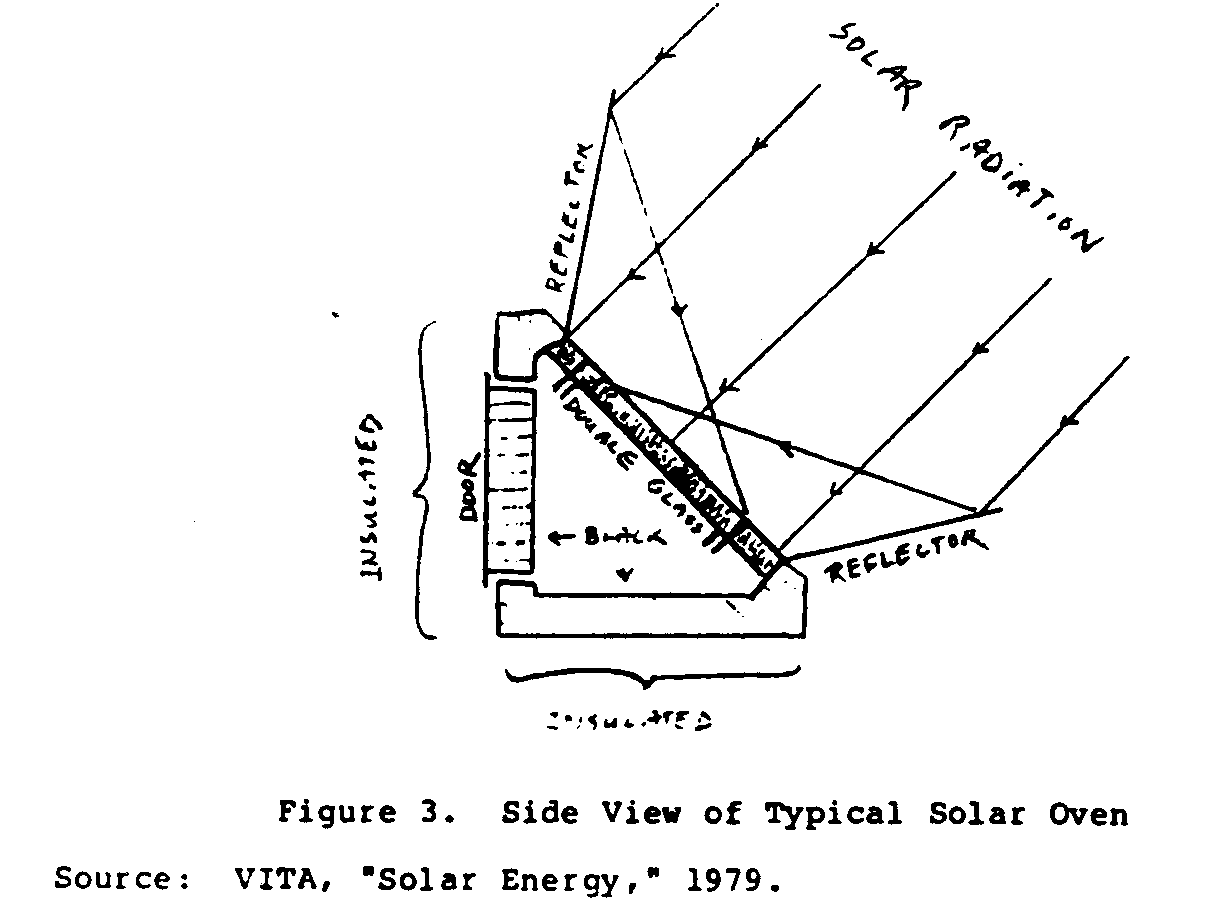
retains heat from the sunlight that is reflected off mirrors extending from the oven's frame. A double glass cover lets light in, but does not allow heat to escape. The let-heat-in-but-not-escape operation is simple, achieving temperatures that may exceed 200 [degrees] C in a well-sealed, well-constructed oven. The cook merely drops whatever needs cooking inside the oven through the back door, or a hinged cover, and the heat does the rest.
Like the solar cooker, the solar oven will function best in strong sunlight. But since the oven is utilizing a greater surface area to absorb heat, it can operate under less than ideal conditions. Of course, the insulated box should be well sealed to prevent unnecessary heat loss.
Solar Stills and Crop Dryers
Also based on the passive solar principle, the solar still is useful for making salty or brackish water fresh. Simple, inexpensive, fuel-thrifty devices for purifying large and small quantities of water are needed in developing countries where potable water is in short supply.
Like solar cookers and ovens, solar stills are easy to assemble and come in different models. All stills consist of a heat-absorbing container in which dirty water can be placed. After reaching a certain temperature, the dirty water in the closed system vaporizes, leaving impurities in the container. Fresh water vapor collects on the surface of the still, condensing on the glass or plastic cover, and slowly trickles into some sort of collection system.
The simple solar still illustrated below (Figure 4) operates
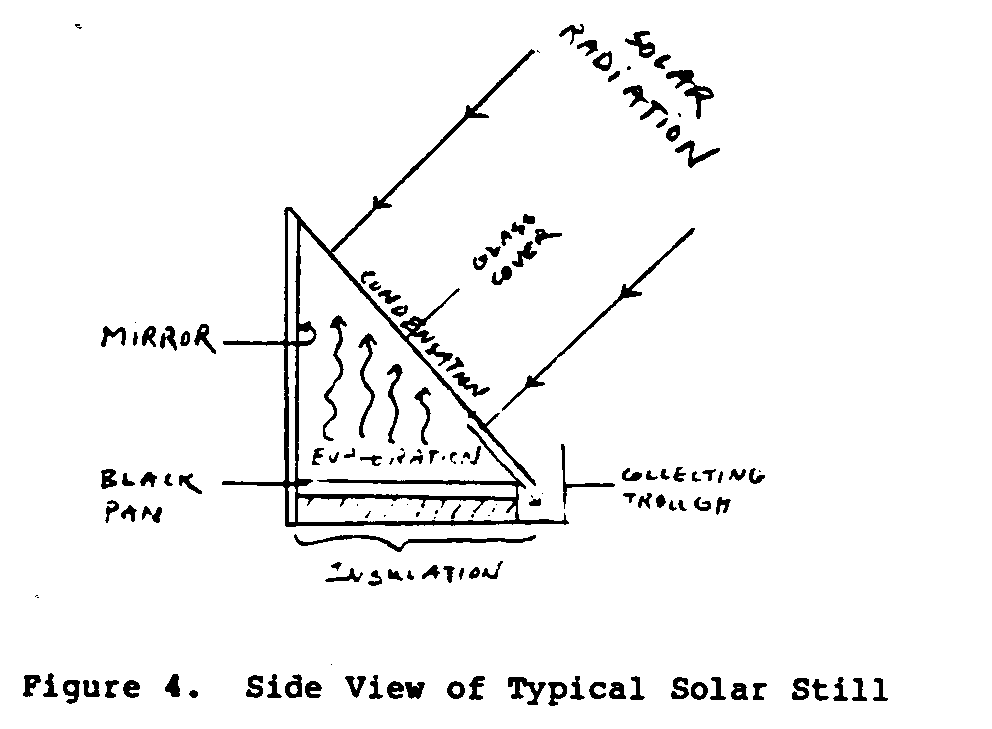
like the solar oven previously described: it absorbs and retains heat. A glass or plastic cover lets radiation in to heat the impure water that sits in the black insulated pan. The well-sealed cover keeps enough heat in to achieve temperatures necessary for distillation.
Solar heat can also be used to dry crops. Indeed, farmers all over the world have been using the sun's heat to dry crops for centuries. But simply hanging or spreading crops outside can lead to substantial crop loss, due to exposure to dirt, animals, insects, molds, and bad weather.
Gas-fired and electric dryers are expensive devices and, of course, the cost of using them increases as fuel prices rise. Small-scale solar dryers, which operate much like the solar oven and still described earlier, can be made easily at low cost, but simple and inexpensive large capacity models are available as well.
According to Daniel Deudney and Christopher Flavin of Worldwatch Institute, a number of different types of dryers are being tested, most with success. For example, a simple solar dryer capable of drying up to one ton of rice at a time is in use in Thailand (see Figure 5). The device consists of three connected parts: a
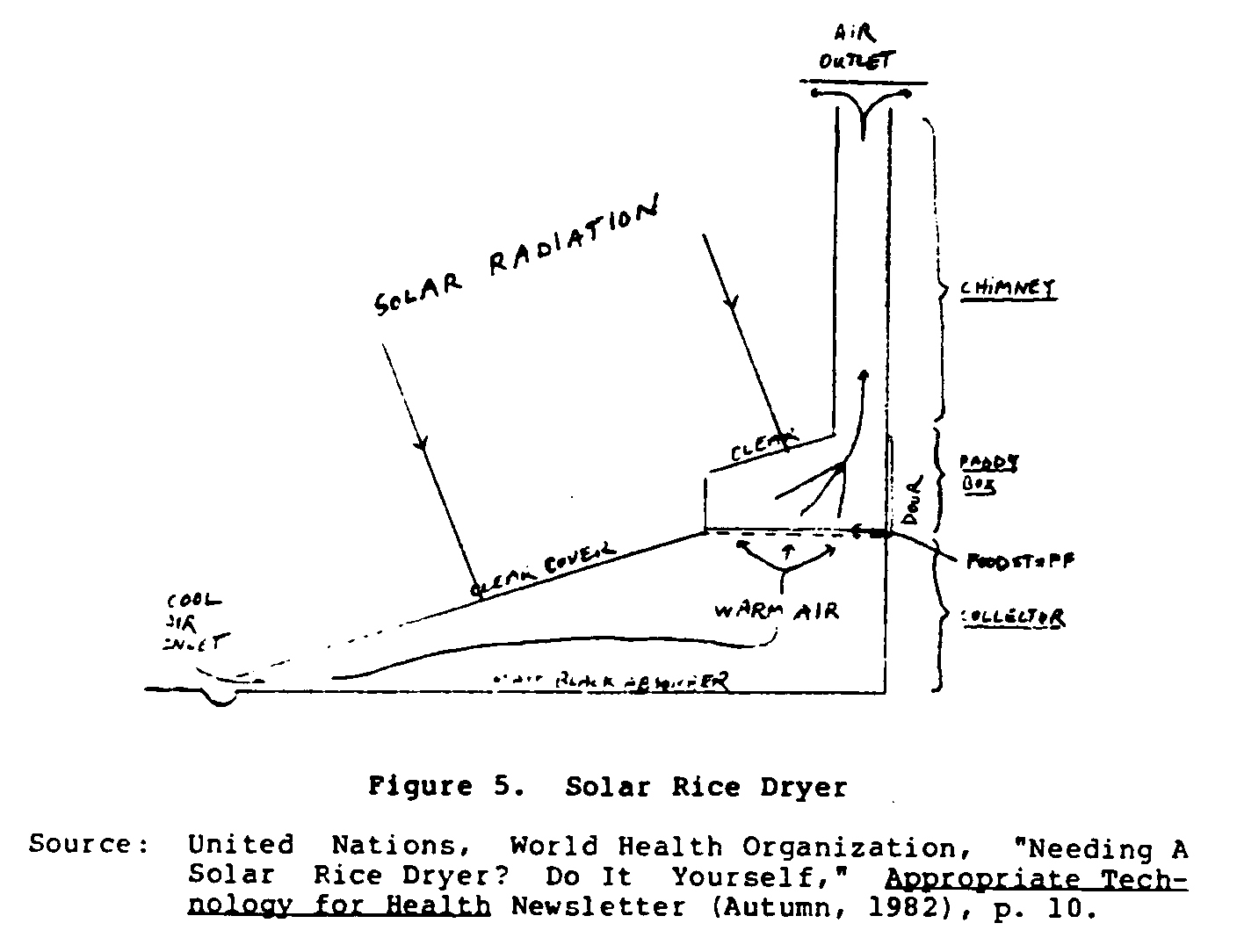
solar collector, a container to hold the rice (known as a paddy box in this model), and a chimney. The collector floor is made of a black substance to help absorb heat and the sides and cover are clear. As in other passive solar technologies, radiation enters the system but cannot escape. The rice or grain is placed in the box, which sits above the collector. Warm air from the collector circulates through holes in the bottom of the box, drying the foodstuff, and passes up and out of the system through a chimney.
According to the Renewable Energy Resources Information Center of the Asian Institute of Technology, the one-ton dryer cost U.S. $150 in Thailand in early 1982. When one considers that drying increases the marketing value of the food, the investment may pay for itself quickly. The Institute also notes that basic tools and equipment can be used to build the dryer and maintenance is simple if the bamboo used to support the system is treated to prevent decay.
Passive Solar Structures
The passive solar principle can be applied on a greater scale in developing countries. Buildings can be designed to operate like large solar collectors, that is, designed to absorb and trap heat. Passive space heating systems contain no mechanical parts and are often cheaper than active space heating systems. A passive system uses the structural components of a building (walls, windows, and floors) to collect and store solar energy. Heat is distributed by the natural processes of convection, conduction, and radiation.
In a passive solar building located north of the equator, most of the windows face south to let in as much sunlight as possible. This principle is reversed in passive buildings south of the equator--most windows face north. Beat is stored in "thermal mass"--thick masonry floors or walls, rock beds, water-filled containers or any combination of these. During the day, the thermal mass absorbs a great deal of heat, particularly if it is in direct sunlight. At night, the stored heat gradually migrates to the living area. In a strictly passive house, this heat moves naturally, without a mechanical boost. However, hybrid systems that incorporate fans or blowers for added circulation are common. At night and during heavily overcast periods, movable insulation in the form of heavy curtains or shades is pulled over the windows to reduce heat loss.
In hotter climates, buildings can be constructed to stay cool. Passive cooling is accomplished through the structure's design, layout and components, as in passive heating. Passive cooling techniques control incoming sunlight and use a variety of methods to encourage cooling air movement.
Sunlight can be kept out by shading windows with overhands, trees, or awnings. Movable insulation can be drawn over windows during the day to reduce heat gain.
Natural ventilation is encouraged by opening the building to summer breezes and providing a clear path for the air to move along. Induced ventilation depends upon use of the chimney effect, where hot air that accumulates is allowed to rise and exit rapidly through high vents. At the same time cooler air from another source (such as a well-shaded north yard) is drawn in.
A number of possible sun- and earth-tempered structures can reduce the energy needed for space beating and cooling. The most appropriate of these structures are simple in design and easily built with local materials. Some forms of traditional housing employ passive solar principles. Northern China has thousands of masonry buildings designed to trap the sun's heat in winter. However, in some countries, this traditional architecture has been replaced by inefficient modern designs.
Batch Water Heaters
Batch heaters are the simplest and most economical solar water heaters. One type of batch heater is simply a black plastic bag of water placed in the sun. Another type of batch heater consists of a ditch that is lined with dark plastic.
PHOTOVOLTAICS
Photovoltaic (PV) conversion has been touted for years as an environmentally acceptable energy source for the future. Initial expectations that photovoltaics would become cost-competitive with conventional energy sources by the mid-1980s were, however, too optimistic. Nevertheless, in many remote locations of the world, where electricity is inaccessible and conventional or traditional fuels are difficult to come by, PV can be cost-competitive. In these isolated rural areas, diesel generators are the prime source of electricity. When one considers the maintenance costs and potential fuel supply shortages of diesel generators, PV is often a viable alternative in rural electricity applications of three kilowatts or less. Moreover, the cost of fuels such as oil and wood is likely to rise while the cost of solar cells should continue to fall.
The availability of electricity in developing countries can greatly improve the quality of life. PV is a clean, reliable source of electricity, easy to use once installed, and transportable. But the solar cell is just one part of a somewhat complicated system needed to provide electricity at the village level. Indeed, most sponsors of PV projects currently under way in developing countries are evaluating the economics of total PV electrical systems. Many small-scale applications are cost-competitive today, but large systems require site construction, installation, some maintenance, batteries for storage, and control circuits to regulate current and/or voltage.
On the other hand, PV comes in modular units, which means that an expanding village could avoid the huge capital outlays necessary to get conventional forms of electricity. In any case, even small amounts of electricity could lead to a substantial improvement in living conditions in developing regions. Photovoltaics have practical applications as sources of power for water pumping, communications, refrigeration, and lighting. PV-powered water pumps are not only useful for agricultural purposes, they also supply safe drinking water in many villages. Open wells can be covered after a pump is installed, thus reducing the risk of disease to drinkers.
In other areas, solar cells are powering microwave telephone systems to link remote locations with industrial and urban areas. As an energy source for television and lighting, PV also contributes to educational programs and enables important village activities and meetings to be held at night. Refrigerators, essential for storing and preserving food, drugs, and ice can also be powered with PV. Unfortunately, their price is relatively high--ranging from about U.S. $2,000 to $5,000.
Progress in photovoltaics research has been impressive over the last 10 years, and numerous research efforts are under way in industrialized and developing nations alike. China, Mexico, India, and Pakistan have extensive research or pilot programs in operation, and many other developing countries are participating on a more modest scale. As research breakthroughs occur and the PV industry continues to mature, the cost of cells is sure to drop. As it does, the cost-effective applications of PV in developing areas will multiply.
III. SUMMARY
This overview has focused on the simplest solar technologies, that is, those least likely to encounter economic and technical barriers during their introduction. Even these are likely to experience cultural impediments that must be understood, confronted, and resolved before total social acceptance is achieved in Third World villages.
Solar energy has many uses in developing regions that are not discussed in this paper, including solar-powered absorbative refrigeration, active space cooling and heating systems, and combination solar systems. However, these are relatively complex and expensive devices. The most appropriate technologies are generally those that follow the simple passive principle.
Experience over the years has proven that applying new energy forms (no matter how simple) to developing areas will almost always meet some sort of resistance or difficulty. The poor in the Third World desperately need cheap, clean, and simple energy technologies to conserve traditional fuels, preserve the environment, and satisfy fundamental human needs. But it is only insightful and sensitive energy planning--identifying problems before they occur--that will make widespread use of solar energy a reality in developing countries.
BIBLIOGRAPHY/SUGGESTED READING LIST
Cecelski, E., et al. Household Energy and the Poor in the Third World. Washington, D.C.: Resources for the Future, Inc., 1978.
Deudney, D., and Flavin, C. Renewable Energy: The Power To Choose, New York, New York: W.W. Norton and Company, 1983.
Giarman, R.K. "Chinese Energy: Satisfying Needs at a Local Level." (unpublished), 1984.
Gregoire, Roger G., P.E. Understanding Solar Food Dryers. VITA Technical Paper 15.
Arlington, Virginia: VITA, 1984.
National Research Council. Supplement, Energy for Rural Development. Washington, D.C.: National Academy Press, 1981.
Smil, V. "Intermediate Energy Technology in China." Bulletin of the Atomic Scientist (February 1977), p. 28.
Swet, C.J. Understanding Solar Water Pumps. VITA Technical Paper 20.
Arlington, Virginia: VITA, 1985.
VITA. Solar Energy. Appropriate Technology and Development Series, Paper #14 (Prepared by VITA for Action/Peace Corps). Arlington, Virginia: VITA, 1979.
VITA. Solar Convection Grain Dryer. VITA Technical Bulletin #63. Arlington, Virginia: VITA, 1981.
VITA. Solar Cooker Construction Manual. Arlington, Virginia: VITA, 1967.
VITA. Solar Water Heater. Arlington, Virginia: VITA, 1980.
World Health Organization. "Needing a Solar Rice Dryer? Do It Yourself." Appropriate Technology For Health, Geneva, Switzerland: World Health Organization, Newsletter 11 (Autumn 1982), p. 10.
"Solar Electricity Generation in Developing Countries." Appropriate Technology for Health, Newsletter 11 Autumn 1982), p. 13.